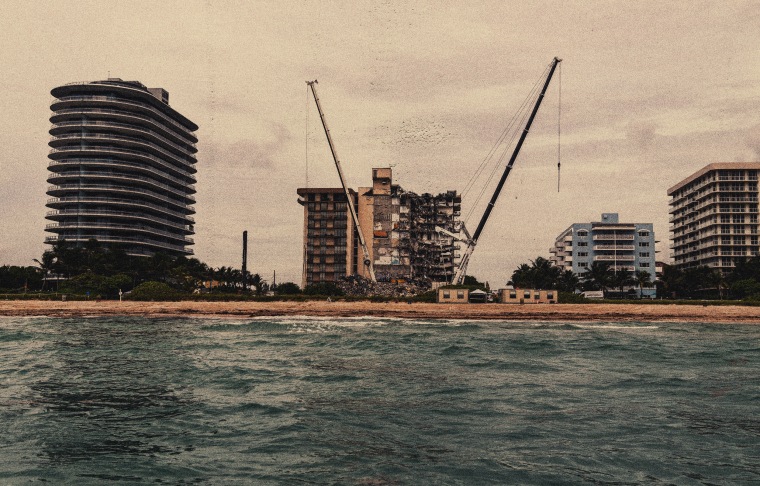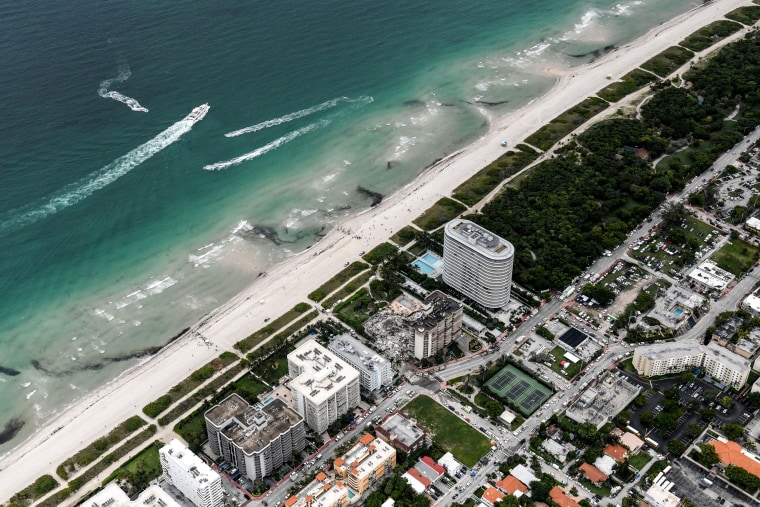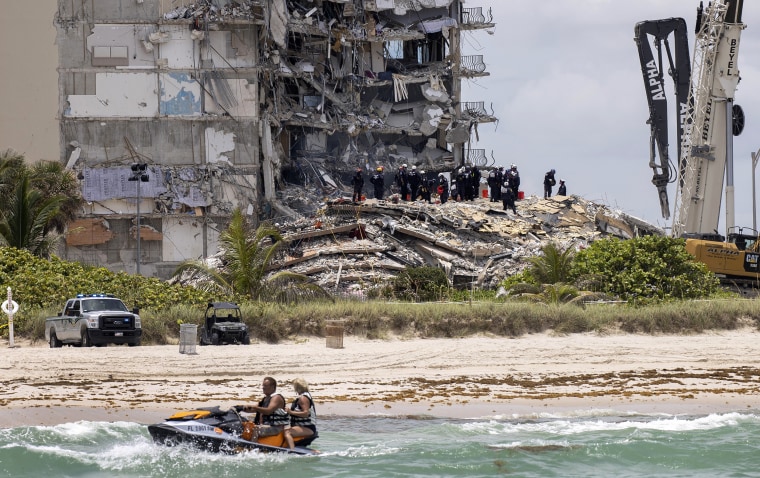Not long after a condo tower collapsed in Surfside, Florida, last June, Randall Parkinson had what he calls an epiphany.
Parkinson, a coastal geologist who studies the impact of climate change at Florida International University in Miami, wondered whether rising sea levels had driven saltwater into the ground beneath the tower, corroding its concrete foundation. Others were asking similar questions, but he couldn’t find anyone who’d researched the effect of saltwater intrusion on residential buildings.
“So I decided to dig a little deeper,” Parkinson said.
More than seven months after the June 24 collapse, which left 98 people dead, there are no definitive answers about what caused the 40-year-old condo, Champlain Towers South, to fall. Parkinson is one of several scientists who believe that the tower may have been damaged by saltwater seeping into its underground foundation.

He and others had previously found that rising sea levels press underground saltwater closer to the foundations of coastal buildings. They also note that photos showed corroded columns and flooding in Champlain Towers South’s underground garage and that staff members reported pumping water out of the garage.
In a December report, a Miami-Dade County grand jury investigating the collapse also theorized that saltwater intrusion had probably damaged the building’s foundation.
Parkinson and other experts stress that they aren’t saying such damage brought down the 12-story building; the cause of the collapse, on a barrier island that includes Miami Beach, is under investigation by federal authorities. Champlain Towers South suffered from construction flaws and extensive above-ground corrosion. Residents complained that its foundation shook during the construction of a tower next door. An environmental scientist has documented that the building had slowly sunk in the 1990s.
But even if saltwater intrusion wasn’t a cause of the collapse, experts say they want to spread awareness of an unseen and overlooked threat that could make many other residential towers on the Florida coast vulnerable to decay.
“I really feel like this was completely missed,” Parkinson said. “You can see coastal erosion. You can see if you’re losing your shoreline or if your property gets flooded. But what you don’t see, and what people really hadn’t begun to think a lot about, is everything that’s occurring hidden underground. It’s out of sight, out of mind.”
Still, Parkinson and other scientists could face challenges in persuading Floridians to take action in response to the threat of rising groundwater, not only because research remains thin, but also because addressing the damage to buildings would likely be expensive and could hinder a condo industry that helps drive the state economy.
Many building foundations are made with steel-reinforced concrete. If it’s not properly protected, the concrete can absorb saltwater, triggering corrosion of the supportive steel inside. That leads to “spalling,” in which the steel rebar expands, crumbling the concrete around it.
In its December report examining condo safety after the collapse, the Miami-Dade County grand jury noted the “open and obvious” spalling at Champlain Towers South and concluded that it was “fairly certain there was unseen corrosion and weakening of the concrete in the foundation and underground pillars.”
The grand jury also warned that saltwater intrusion could pose a significant danger beyond Champlain Towers South, saying it “may be creating hazardous conditions that will negatively impact concrete pillars and foundations that are providing support to building structures, especially those in coastal communities.”
The panel’s foreman declined to comment on the findings, as did a spokesman for the Miami-Dade State Attorney’s Office, citing confidentiality rules. The grand jury was tasked with exploring the public safety implications of the collapse, not with recommending criminal charges. That work will be taken up by local prosecutors after federal authorities determine the cause.
In November, Parkinson published the first peer-reviewed study on the issue of rising sea levels’ underground attack on residential buildings, which was later reported by The Palm Beach Post. Using data from nearby monitoring wells, Parkinson showed that, with sea level rise, the number of times groundwater rose above the level of Champlain Towers South’s garage floor increased from an average of 244 times a year from 1994 to 2006 to 636 times a year from 2007 to 2020.
Although Parkinson wasn’t able to obtain data on the water’s salinity, he hypothesized that during the natural tidal cycle, particularly during extremely high “king tides,” underground seawater and the freshwater layer above it — called a “lens” — probably mixed. The frequency of mixing will increase as sea levels continue to rise, Parkinson said.
“Ultimately it’ll all go to salt,” Parkinson said. “The ocean will be so high and will flood the area and there will be no freshwater lens. We are just at the beginning of this and don’t have enough to know what it’s like now, but we can speculate where this is going.”

An hour or so up the coast from Parkinson’s office, two professors at Florida Atlantic University have been pursuing a similar theory. After the collapse, Fred Bloetscher, a civil engineer who studies how sea level rise affects municipal water systems, called Anthony Abbate, an architect focused on protecting buildings from climate change. They’d talked before about the possibility that the steel-reinforced concrete in a building’s foundation could fail from deterioration caused by rising levels of salty groundwater.
“Do you think this could be a factor?” Bloetscher asked.
“I don’t know, but it sure looks like it,” Abbate replied.
In mid-December, Bloetscher, Abbate and a Florida Atlantic University colleague, Khaled Sobhan, submitted a study titled “Can Sea Level Rise and Accompanying Saltwater Intrusion Contribute to Catastrophic Building Failures?” to Technology | Architecture + Design, a peer-reviewed journal. Using a similar methodology to Parkinson’s work, the study said water-level data indicated that Champlain Towers South’s foundation, including piles, columns, walls and the garage floor, “may have been exposed to periodic saltwater, which is known to accelerate corrosion, in increasing amounts and with more frequency.”
Abbate said he has been trying for years to get architects and builders interested in the issue. Until now, he said, studies of the risks of saltwater corrosion have largely focused on parts of buildings that are above ground or on public infrastructure, such as bridges, roads and water systems; in Fort Lauderdale, where Abbate is based, saltwater intrusion has contributed to a series of bursting sewer pipes. But the collapse of Champlain Towers South added a sense of urgency to a new potential threat.
“Surfside was a very tragic and unexpected outcome of processes we believed may have been going on but never had a clear study or funded research to show this,” Abbate said.

More scientific studies could help bring changes to building codes, which Abbate said could require testing that shows the depth and salinity of the water beneath buildings. New codes could also require that foundations be designed to better protect from corrosion. Ideally, foundations would be equipped with sensors allowing building owners to collect data on a building’s “vital signs,” Abbate said.
He and Bloetscher want to conduct more studies of properties in South Florida to get a better understanding of the potential risk. Since the Surfside collapse, they’ve given talks on the topic to local construction and design professionals. Engineers, bankers and contractors seem interested, but representatives of the real estate and insurance industries express less worry, Bloetscher said.
He added that Florida condo laws and the politics of condo boards don’t encourage deeper investigation of potential threats because they can be expensive and hurt the real estate market.
“The biggest concern I have is if it was a factor at Champlain Towers South, which we suspect it is, then this exists in many places and it’s unseen,” Bloetscher said of rising groundwater. “That’s my real concern, that this is unseen and there’s no reason why it doesn’t happen again.”
Harold Wanless, a University of Miami geologist who has been warning about the effects of sea level rise in Florida for decades — and who once taught Parkinson — said he agreed that Parkinson had identified a blind spot in the study of saltwater intrusion. But he cautioned that it remains unclear whether seawater actually infiltrated the foundation of Champlain Towers South. “Without the data, we should be careful saying the saltwater ate up the concrete,” Wanless said.
Michael Sukop, a hydrogeologist at Florida International University, said he, too, has grown interested in saltwater’s attack on concrete foundations of buildings like Champlain Towers South. He is working on a project measuring how saltwater intrusion might affect the concrete in coastal building foundations. It’s difficult to figure that out in Surfside, because there isn’t enough information about the amount of saltwater in the ground, he said.
“I’d like to see more monitoring for freshwater/saltwater interfaces on barrier islands and on the mainland,” Sukop said. “Otherwise, we have trouble answering these questions.”
